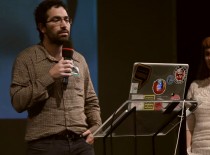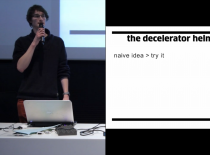Prague - December 7, 2012
Alexander Cetkovic presents his paper within the panel Beyond Uncertainty at International conference MutaMorphosis in Prague, Czech Republic.
The language of architecture has evolved with human culture and has built a repertoire of forms and topoi that we take for granted without being forced to constantly reflect about the meanings of these forms. We perceive and orient ourselves in the built environment without interpreting every form or space separately. However, this is not usually the case in the architecture of change. In such responsive environments, the changes are often so omnipresent and explicit that the interactor’s attention is fixed during these changes. There might be situations in which demanding full attention while the environment changes is necessary. But as a general rule, such an approach cannot serve as a model for future architecture. This is because, if all technology, flexible architecture included, is to compete for the attention of the user, the consequence will be a dissonance and overload of signals and events – a scenario which the user would try to avoid or ignore altogether.
One approach by which responsive architecture may become a part of our lives as static architecture has is to adapt it in such a way that only our peripheral awareness is stimulated. But for this architecture to function properly, it needs to communicate with its users. Can this be achieved without demanding the full attention of the user? What could be the strategies for such architecture to inform the users unconsciously and to obtain the input necessary to perform properly? Is such architecture still deterministic, or would this kind of interpretational architecture lead to non-determinism and the emancipation of the user from the will of the architect?
- Tags:




 Copyright © 2025 ARTISTTALK. All Rights Reserved.
Copyright © 2025 ARTISTTALK. All Rights Reserved.
0 Comments
You can be the first one to leave a comment.